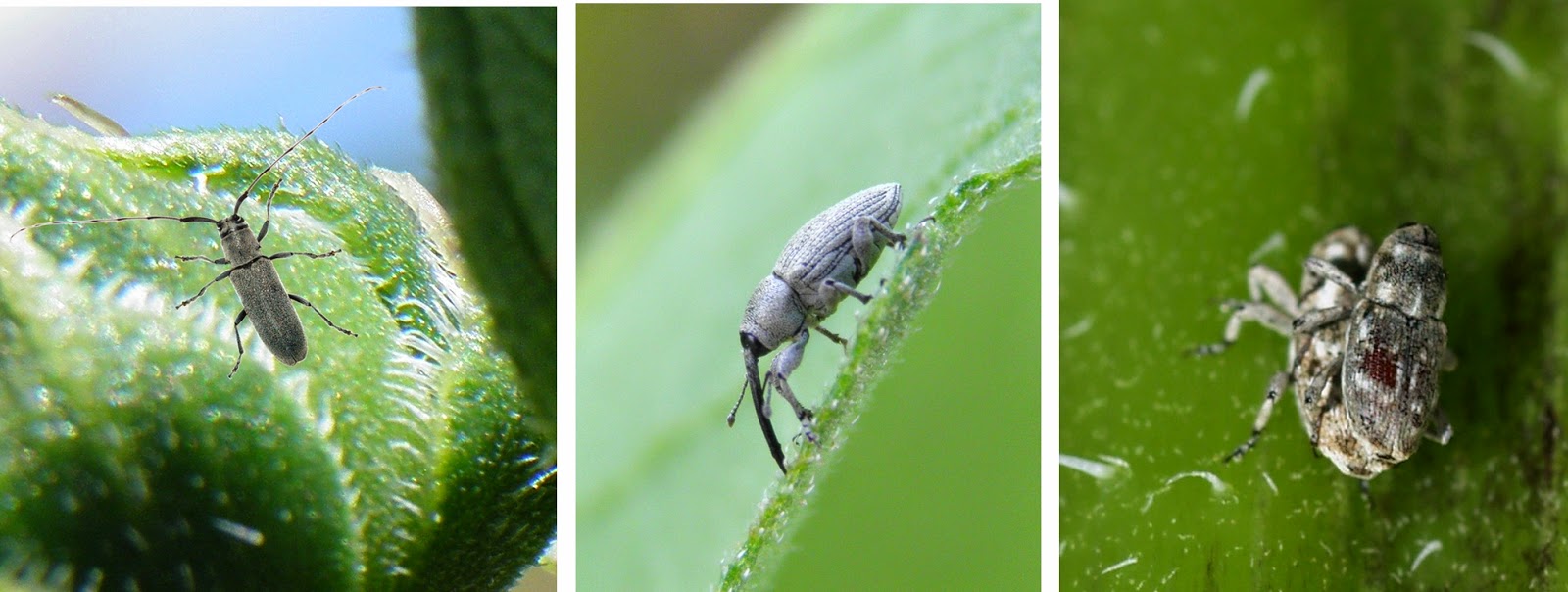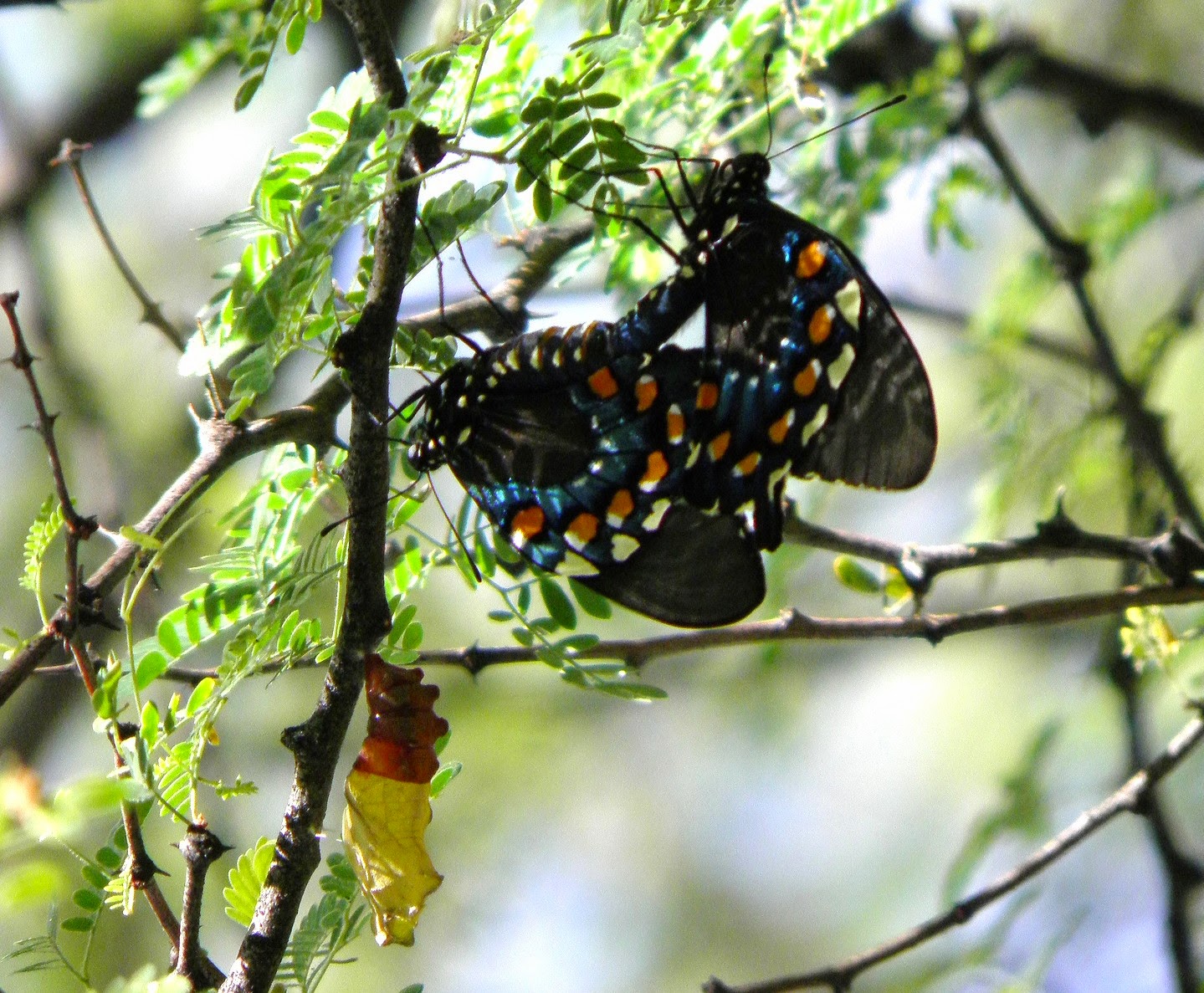Wikipedia says it quite correctly: "A new honey bee colony is formed when the
queen bee leaves the colony with a large group of
worker bees, a process called
swarming. In the
prime swarm, about 60% of the worker bees leave the original hive location with the old queen. This swarm can contain thousands to tens of thousands of bees. Swarming is mainly a spring phenomenon, usually within a two- or three-week period depending on the locale, but occasional swarms can happen throughout the producing season."
So 'Italian' Honey Bees are supposed to do this in spring, and not too often. But our Arizonan Africanized swarms seem to break up more frequently, and you see small swarms at all times of the year. Big swarms are important for effective communal thermoregulation in winter. The Italian bees, supported by their keepers, usually survive very low temperatures by shivering and huddling. The African Bees are not that cold tolerant - so in Germany and the northern US cold winters kill them off, but in Arizona they often survive, even in feral hives. Therefore all feral hives here are assumed to be Africanized.
Accordingly, here in Picture Rocks our feral bee populations were greatly reduced after the very cold winter of 2012/13. In spring of 2013, we saw very few honey bees at hummingbird feeders and bird baths. (we don't have any close by bee keepers). But all through 2014 I saw again swarms searching for homes, Saguaro holes turned into bee hives and bees visiting the humming bird feeders. The (probably Africanized) honey bee population of Picture Rocks Arizona is bouncing back just fine.
Local endemic bees beware, they are going to be strong competition again.
![]() |
| Feral honey bees drinking at a bird bath. The whole rim was covered like this. Bees are not aggressive in this situation, or when they nectar on flowers |
In the past swarming bees used to alarm the public. Africanized Bees were seen as a deadly menace. With some justification. If those bees try to defend their hive, be careful. With hive I mean an established colony that has honey combs, and most importantly eggs and larvae to defend. They may attack if you get close and or do disturbing things like hammering around them.
![]() |
| This saguaro hole on our property house bees for years. That high up they felt safe and never caused any trouble |
If you run they will follow, but not very far. A few stings are what you will suffer before you have outrun them. But deaths have occurred when people stood their ground and swatted or were unable to get away. The sad case of a rock climber who died hanging in his harness speaks for itself.
![]() |
| Resting swarm. Not dangerous at all |
But when swarms are encountered out in the open
before they find a new home and become territorial there is no threat to the observer. The queen lands on a branch, all others follow, held together by her pleasant smell. A big obvious cluster of bees hangs in a tree. Scouts will be sent out, looking for a nice hole that might be the new homestead. You can only hope that they do not chose the rafters of your house. But the big, scary clump of bees in the tree is harmless. The stomachs of these travelers are full of provisions for the journey, and they are lazy and 'docile' no matter which subspecies they belong to. No need to run from a swarm like that. The worst that can happen: the queen lands in your beard. Then you may end up covered in bees. But not stung.
Over the last years, the mass media popularized the demise of pollinators and in that context hyped up the buzz-word 'bee hive collapse'. To the ecologist these are two different phenomena. Endemic pollinator populations are definitely suffering all over the world. Drought and climate change, intensified agriculture, monocultures, pesticides, weed control along roads and between fields that eliminates their food and kill them directly play an important role. Equally detrimental: development, and
even overly groomed gardens where mulch and plastic foil covers breeding grounds and dead wood and plant material needed for breeding is cleaned away. It makes reproduction impossible and no pretty 'bee hotels' can make up for the loss of natural breeding places.As for the
honey bee hive collapse, it is a syndrome where a number of factors act together. Mites and neonicotines certainly play their roles. So does insufficiant winter food, after too much honey is removed and replaced with poor substitutes. But industrialized bee keeping/agriculture poses a problem that is more difficult to pin down. Millions of bees are shipped all over the continent, shuttling constantly between almond orchards in California, rape fields (Canola) in the north, and wherever else big monocultures demand pollinators in unnatural numbers. Thus infectious germs are distributed in a modern, borderless fashion.
![]() |
| This container truck full of bee hives overturned. But even save travel means stress for bees that rely on a sophisticated orientation system which has to be confused whenever they are shipped long distance |
Stress weakens the immune system, not just in humans. Aquaculture researchers in Norway clearly demonstrated the negative impact of transport stress on the survival rates of smalt (young salmon) that were shipped from breeding facilities to aquaculture farms. Those smalts died from common fish diseases, but the fatality numbers were clearly correlated with the stress the fish were experiencing in transport. Bees may well be as susceptible to stress as baby salmons. But so far, bee keepers are quite able to replace their losses by starting new colonies. The numbers of hives were rising over the last decade, not falling. The real problem: the demand for almonds is rising even more (demand from China). Our bees and bee keepers may soon be at capacity and not able to keep up with ever growing almond orchards.
As press releases about the sad fate of pollinators are reaching the public, the trend here in AZ has slowly changed from concern about dangerous killer bees to concerns about the well being of our Honey Bees. Again, as a biologist I'd say that the imported honey bees and the invasive feral bees (same thing but escaped from the care of the bee keepers) are by far not as important as our less visible endemic bees. But any kind of public concern about the well-being of mere insects should probably be applauded.
Lately I have seen a number of facebook entries that described honey bees that were inexplicably dying. The assumptions ranged from poisonous nectar of blooming Tamarisk (invasive, bad in so many ways, but not killing honey bees who actually originated in the same area the tamarisk was imported from), to a neighbor with a poison spray gun (hey, why not? It's possible) to Carpenter Bees attacking the hive, killing the inhabitants and stealing the honey..
![]() |
| Photo by Les Stewart, with permission |
In Germany a famous children story (Die Biene Maja by
Waldemar Bonsels) describes a raid of Hornets (Vespa crabro) on a bee hive - they catch the honey bees, masticate them into food for young hornets and they steal the honey. As a kid, the terrible story kept me awake at night but is at least conceivable. Wasps and hornets are predators and stored
honey and pollen does get stolen, by other bees, beetles, birds, bears and men.
But Carpenter Bees killing big numbers of honey bees? First I need to mention that some eastern
Carpenter Bees may look similar to big honey bees. But a picture came with the story, the
assumed culprit impaled on a huge pin. By the way, I am not trying to ridicule the photographer. He observed the interesting phenomenon, asked questions, and even collected the evidence. To me, it told the story:
On the pin was a dead male honey bee, a drone.
While most of the inhabitants of a bee hive are females and sisters, all daughters of the mother queen, at certain times a number of males hatch from the brood cells. They have only one purpose: they will mate with new queen bees that are also emerging at that time. Young queens and drones go one bridal flights to mate, and the queen will store sperm to produce hundreds of offspring from just one mating. So the role of the males is over after that one romantic adventure. Since they have nothing else to contribute to the well-being of the hive, the workers will not feed them. They will actually not let them back into the hive. Scuffles may happen when the gate keeper bees refuse entrance to the returning drones. Observers may think an attack is going on. No. It's just the expulsion of the useless drones. But dead bees can be found at that time. At the hive entrance, but also under a tamarisk tree close by. Look into their eyes. They are drones.
![]()
Here is a close-up of the swarm above. You can see the huge drone on the right. His eyes are big and touch on top of his head: he will be able to not just smell his beloved but see her in his aerial pursuit. Check out the smaller worker bee on the left with widely spaced eyes.











.jpg)


















































